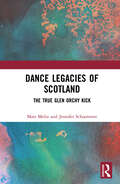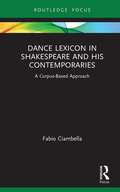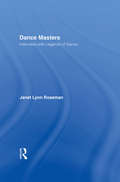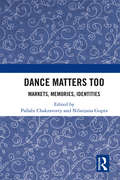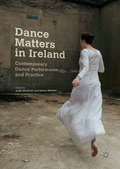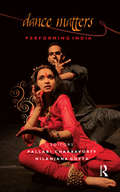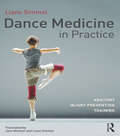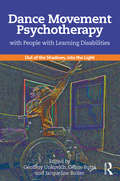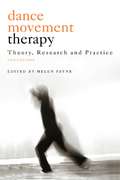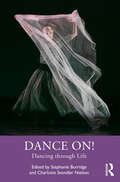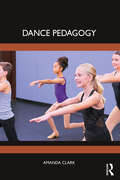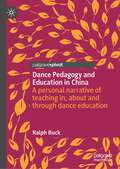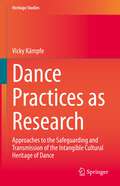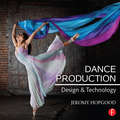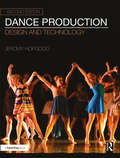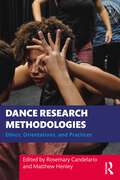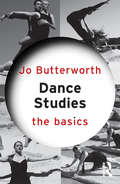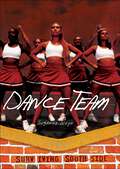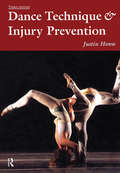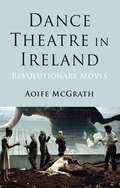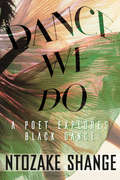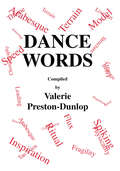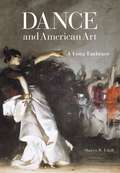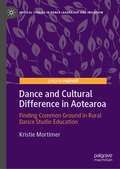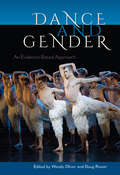- Table View
- List View
Dance Legacies of Scotland: The True Glen Orchy Kick
by Mats Melin Jennifer SchoonoverDance Legacies of Scotland compiles a collage of references portraying percussive Scottish dancing and explains what influenced a wide disappearance of hard-shoe steps from contemporary Scottish practices. Mats Melin and Jennifer Schoonover explore the historical references describing percussive dancing to illustrate how widespread the practice was, giving some glimpses of what it looked and sounded like. The authors also explain what influenced a wide disappearance of hard-shoe steps from Scottish dancing practices. Their research draws together fieldwork, references from historical sources in English, Scots, and Scottish Gaelic, and insights drawn from the authors’ practical knowledge of dances. They portray the complex network of dance dialects that existed in parallel across Scotland, and share how remnants of this vibrant tradition have endured in Scotland and the Scottish diaspora to the present day. This book will be of interest to scholars and students of Dance and Music and its relationship to the history and culture of Scotland.
Dance Lexicon in Shakespeare and His Contemporaries: A Corpus Based Approach (Studies in Performance and Early Modern Drama)
by Fabio CiambellaThis book provides a thorough analysis of terpsichorean lexis in Renaissance drama. Besides considering not only the Shakespearean canon but also the Bard’s contemporaries (e.g., dramatists as John Marston and Ben Jonson among the most refined Renaissance dance aficionados), the originality of this volume is highlighted in both its methodology and structure. As far as methods of analysis are concerned, corpora such as the VEP Early Modern Drama collection and EEBO, and corpus analysis tools such as #LancsBox are used in order to offer the widest range of examples possible from early modern plays and provide co-textual references for each dance. Examples from Renaissance playwrights are fundamental for the analysis of connotative meanings of the dances listed and their performative, poetic and metaphoric role in sixteenth- and seventeenth-century drama. This study will be of great interest to Renaissance researchers, lexicographers and dance historians.
Dance Masters: Interviews with Legends of Dance
by Janet Lynn RosemanDance Masters is a lively ensemble of conversations with seven celebrated dancers and choreographers. In these intimate interviews, dance critic Janet Lynn Roseman probes the heart of dance: * The creative process * The role of dream and rituals * The interplay between dancer and audience * The spiritual aspects of performance These dance masters offer rare insights into the internal world of the artist as they reveal their philosophies on dance training, discuss their mentors, and speak candidly about the artistic process of dance-making and how it actually feels to dance.
Dance Matters Too: Markets, Memories, Identities
by Pallabi Chakravorty Nilanjana GuptaDance Matters Too: Markets, Memories, Identities is a rich intellectual contribution to the growing field of dance studies in India. It forges new avenues of scholarly inquiry and critical engagement and opens the field in innovative ways. This volume builds on Dance Matters (2009), which mapped the interdisciplinary breadth of the field. The chapters presented here continue to underline the uniqueness of a field that is a blend of critical scholarship on aesthetics and performance with the humanities and social sciences. Including diverse material, analytical approaches and perspectives from scholars and practitioners, this multidimensional volume explores debates on dance preservation and tradition in globalizing India, multimedia choreographies and the circulation of dance via electronic media, embodiment and memory, power, democracy and bourgeoning markets, classification and censorship, and corporatization and Bollywood. This tour de force will appeal to those in dance and performance studies, cultural studies, sociology as well as to readers interested in tradition, modernity, gender and globalization.
Dance Matters in Ireland: Contemporary Dance Performance and Practice
by Aoife McGrath Emma MeehanThis book addresses the need for critical scholarship about contemporary dance practices in Ireland. Bringing together key voices from a new wave of scholarship to examine recent practice and research in the field of contemporary dance, it examines the excitingly diverse range of choreographers and works that are transforming Ireland's performance landscape. The first section provides a chronologically-ordered collection of critical essays to ground the reader in some of the most important issues currently at play in contemporary dance in Ireland. The second section then provides an interrogation of individual choreographers' processes. The book traces new choreographic work and trends through a broad array of topics, including somatics in performance, screendance, cultural trauma, dance archives, affect studies, feminist perspectives, choreographic process, the dancer's voice, interdisciplinarity, and pedagogical paradigms.
Dance Matters: Performing India on Local and Global Stages
by Pallabi Chakravorty Nilanjana GuptaThis volume presents a multidisciplinary perspective on dance scholarship and practice as they have evolved in India and its diaspora, outlining how dance histories have been written and re-written, how aesthetic and pedagogical conventions have changed and are changing, and how politico-economic shifts have shaped Indian dance and its negotiation with modernity.. Written by eminent and emergent scholars and practitioners of Indian dance, the articles make dance a foundational socio-cultural and aesthetic phenomena that reflects and impacts upon various cultural intercourses -- from art and architecture to popular culture, and social justice issues. They also highlight the interplay of various frameworks: global, national, and local/indigenous for studying these diverse performance contexts, using dance as a critical lens to analyse current debates on nationalism, transnationalism, gender and sexuality, and postcolonial politics. At the performace level, some articles question the accepted divisions of Indian dance (‘classical’, ‘folk’, and ‘popular’) and critique the dominant values associated with classical dance forms. Finally, the book brings together both experiential and objective dimensions of bodily knowledge through dance.
Dance Medicine in Practice: Anatomy, Injury Prevention, Training
by Liane SimmelDance Medicine in Practice is the complete physical textbook for dance, written specifically to help dancers understand the anatomy, function and care of their bodies. Specific chapters are devoted to focusing on the spine, pelvis, hips, knees, feet, shoulders and arms. Each of these covers the following key aspects: Anatomy: bone structure, musculature, and function. How each part of the body moves and how it responds under pressure Pitfalls: Common examples of bad practice and the effect that these can have on the body Self Analysis: How to become aware of and muscle groups and the capacity of each joint. Injury Prevention: Tips and advice on how to best avoid and prevent injury both in training and everyday life Exercises: Simple and effective methods of strengthening, mobilising and relaxing joints and muscles Checklists: Dos and Don'ts for the best dance technique. The best dancers know that looking after their bodies is the key to their success, and Dance Medicine in Practice also covers how to ensure the best possible nutrition, plan and manage training schedules, and ensure that injuries are kept to a minimum both in frequency and impact. It is the best possible companion to a life in dance.
Dance Movement Psychotherapy with People with Learning Disabilities: Out Of The Shadows, Into The Light
by Céline Butté Jacqueline Butler Geoffery UnkovichThis book provides an overview of dance movement psychotherapy for young people and adults with learning disabilities. Contributors from a variety of backgrounds examine their work with clients from across the disabilities spectrum, ranging from mild to complex needs. The book chapters present theory and practice relating to the client group and subsequent therapy processes. This comprises psychotherapeutic interventions, dance movement interventions, theoretical constructs, case study material, practitioner care, and practitioner learning and development related to individual and group therapy work. The logistics of a Dance Movement Psychotherapy intervention, the intervention itself and the ripples of influence into the clients’ wider socio-cultural context are discussed. This stance speaks to current research and practice discourse in health and social care. The book champions acceptance of difference and equality in the health and social care needs for people with learning disabilities whilst emphasising the importance of dance movement psychotherapy for people with non-verbal communication. Dance Movement Psychotherapy with People with Learning Disabilities: Out of the Shadows, into the Light will provide a practical and theoretical resource for practitioners and students of dance movement psychotherapy as well as allied health professionals, service providers and carers.
Dance Movement Therapy: Theory, Research and Practice
by Helen PayneWhat can dance movement contribute to psychotherapy? This thoroughly updated edition of Dance Movement Therapy echoes the increased world-wide interest in dance movement therapy and makes a strong contribution to the emerging awareness of the nature of embodiment in psychotherapy. Recent research is incorporated, along with developments in theory and practice, to provide a comprehensive overview of this fast-growing field. Helen Payne brings together contributions from experts in the field to offer the reader a valuable insight into the theory and practice of Dance Movement Therapy. The contributions reflect the breadth of developing approaches, covering subjects including: dance movement therapy with people with dementia group work with people with enduring mental health difficulties transcultural competence in dance movement therapy freudian thought applied to authentic movement embodiment in dance movement therapy training and practice personal development through dance movement therapy. Dance Movement Therapy will be a valuable resource for anyone who wishes to learn more about the therapeutic use of creative movement and dance. It will be welcomed by students and practitioners in the arts therapies, psychotherapy, counselling and other health and social care professions.
Dance On!: Dancing through Life
by Charlotte Svendler Nielsen Stephanie BurridgeBurridge and Svendler Nielsen bring together many perspectives from around the world on dancing experiences through life of senior artists and educators, whether as professionals working with community dance groups, in education or for recreation and well-being. Broadening our understanding of the burgeoning sector of maturing dances and dancers, this book incorporates a range of theoretical approaches with an emphasis on cultural and experiential dimensions. It includes examples of how artists, community practitioners, teachers, policy makers and academics work to better understand, promote and create new ways of thinking and working in the field of dance performance, education and well-being. Each section of the book includes a mixture of chapters based on research and case narratives focusing on practitioners’ experience, as well as conversations between world-renowned mature dance artists and choreographers. It features an eclectic mix of lived experiences, wisdom, deep knowledge and reflection. The book is a valuable resource for students of performing arts, pedagogy, choreography, community dance practice, social and cultural studies, aesthetics, interdisciplinary arts, dance therapy and more. Artists working across generations and in communities can also find useful inspiration for their continued dance practice.
Dance Pedagogy
by Amanda ClarkDance Pedagogy is a comprehensive resource designed for dance students and teaching artists to develop skills and strategies in the multifaceted practice of teaching dance.This invaluable resource features essential components and considerations necessary for the dance teacher in any setting, including the private and community sector, university setting, and professional venues. Five distinct units provide insight into the paradigm, learning process, class environment factors, planning, and delivery of the dance class in a broad context through the use of examples within the dance forms of ballet, jazz, modern, tap, and hip-hop. Readers intently explore cognitive and motor learning, strategies for developing curricula and lesson plans, and methods of delivering material to students. Basic principles of anatomy, understanding student behavior and participation, the importance of diversity, equity, inclusion and accessibility (IDEA), music concepts for the dancer, injury prevention, and classroom management are included to provide a well-rounded approach to the many challenges faced in the classroom.Dance Pedagogy provides the most holistic approach available in the art of teaching dance and is a core textbook for academic courses related to Dance Teaching Methods as well as an invaluable handbook for practicing dance teachers.
Dance Pedagogy and Education in China: A personal narrative of teaching in, about and through dance education
by Ralph BuckThis pivot offers an innovative approach to dance education, bringing a creative and inclusive dance education pedagogy into Chinese dance classrooms. Associate Professor Ralph Buck’s experiences of teaching dance at the Beijing Dance Academy and the possible implications for dance education in China lie at the heart of this text. Through a critical examination of personal teaching practice, pedagogical issues, trends and rationales for dance education in the curriculum are highlighted. Informed by constructivist ideals that recognise dialogue and interaction, this pivot suggests that dance can be re-positioned and valued within educational contexts when pedagogical strategies and objectives are framed in terms of teaching and learning in, about and through dance education.
Dance Practices as Research: Approaches to the Safeguarding and Transmission of the Intangible Cultural Heritage of Dance (Heritage Studies)
by Vicky KämpfeThis book contributes to the growing scientific literature on ‘intangible cultural heritage’ – determined by UNESCO to be particularly worthy of safeguarding and transmission – by advancing a theoretical-analytical framework for the (in)tangible cultural heritage of dance. By exploring the potential of the ‘intangible materiality’ of dance practice the book argues that implementing the concept of a ‘performative dance-archive’ creates a new analytic field: research in praxis. The concept of the ‘performative dance-archive’ draws out the potential for safeguarding and transmission of dance heritage, but also the challenges of the opposition between living heritage and the codifying of cultural inventories. This book uses the formal and contextual transformation of Argentine tango and German modern dance to discuss this ambiguity of intangible heritage and how the “performative dance-archive” creates a cognitive, empractical approach to determine, archive, and distribute dance knowledge. This is a timely methodological intervention in the context of the increasing importance of the intangible cultural heritage. It enables us to re-revise the concept of (im)materiality and the specific knowledges within cultural practice as a necessary fundamental category for research-processes and societal growth. This book is directed both to researchers in the field of intangible cultural heritage and to practitioners and researchers searching for new ways of investigating methods and perspectives to understand 'immaterial materialities'.
Dance Production: Design and Technology
by Jeromy HopgoodDance Production: Design and Technology introduces you to the skills you need to plan, design, and execute the technical aspects of a dance production. While it may not seem that staging a dance production is that different from a play or musical, in reality a dance performance offers up unique intricacies and challenges all its own, from scenery that accommodates choreography, to lighting design that sculpts the body, and costumes that complement movement. This unique book approaches the process of staging a dance production from a balanced perspective, making it an essential resource for dancers and designers alike. Covering a broad range of topics, author Jeromy Hopgood takes the reader through the process of producing dance from start to finish – including pre-production planning (collaboration, production process, personnel, performance spaces), design disciplines (lighting, sound, scenery, costumes, projections), stage management, and more. Bridging the gap between theatrical and dance design, the book includes a quick reference guide for theatrical and dance terminology, useful in giving dancers and designers a common working vocabulary that will ensure productive communication across the different fields.
Dance Production: Design and Technology
by Jeromy HopgoodDance Production: Design and Technology, Second Edition is an introduction to the skills needed to plan, design, and execute the technical aspects of a dance production.Covering a broad range of topics, author Jeromy Hopgood takes the reader through the process of producing dance from start to finish. Part I addresses the collaborative process, business and organizational concerns for dance companies, planning the production, and the relationship between dance and performance spaces/staging methods. In Part II, each unique production area is examined, including production and stage management, sound, costume and makeup, scenery and props, lighting, and projection/video design. Each design area is divided into two chapters – the first introducing key concepts, and the second focusing on the process of creating the design. Part III brings back the popular quick reference guides from the first edition, providing an expanded and revised tool to bridge the language gap between the worlds of theatrical production and dance, and ensure productive communication across the different fields. This second edition features updated information on technology and processes, two new chapters on touring and non-traditional productions, more information on arts management within dance production, a comprehensive look at dance and video (including remote/streaming performances, as well as dance film), and additional chapter projects throughout the book.This unique book approaches the process of staging a dance production from a balanced perspective, making it an essential resource for choreographers, theatre designers, dancers, and management personnel alike, including for use in Dance and Dance Production courses.
Dance Research Methodologies: Ethics, Orientations, and Practices
by Rosemary CandelarioDance Research Methodologies: Ethics, Orientations, and Practices captures the breadth of methodological approaches to research in dance in the fine arts, the humanities, the social sciences, and the natural sciences by bringing together researchers from around the world writing about a variety of dance forms and practices. This book makes explicit the implicit skills and experiences at work in the research processes by detailing the ethics, orientations, and practices fundamental to being a researcher across the disciplines of dance. Collating together approaches from key subdisciplines, this book brings together perspectives on dance practice, dance studies, dance education, dance science, as well as dance research in cross-, multi-, and interdisciplinary fields. Practice-based chapters cover methodological approaches that provide rich examples of how research design and implementation are navigated by practicing scholars. Dance Research Methodologies also includes a practical workbook that helps readers to decide upon, refine, and enact their research, as well as develop ways in which to communicate their process and outcomes. This vital textbook is a valuable resource for research faculty interested in interdisciplinary conversation and practice, emerging scholars honing their methodological approaches, graduate students engaged in research-based coursework and projects, and advanced undergraduates.
Dance Studies: The Basics (The Basics)
by Jo ButterworthA concise introduction to the study of dance ranging from the practical aspects such as technique and choreography to more theoretical considerations such as aesthetic appreciation and the place of dance in different cultures. This book answers questions such as: Exactly how do we define dance? What kinds of people dance and what kind of training is necessary? How are dances made? What do we know about dance history? Featuring a glossary, chronology of dance history and list of useful websites, this book is the ideal starting point for anyone interested in the study of dance.
Dance Team (Surviving Southside)
by Charnan SimonIzzy's the newest member of the Southside High dance team. And she may have picked a bad time to join up. The team's captain, Camilla, is determined to win regionals by any means necessary. When the dance team discovers that Izzy is best friends with the leader of a rival squad, the pressure's on. Will Izzy injure her old friend to sabotage Southside's competition?
Dance Technique and Injury Prevention (Ballet, Dance, Opera And Music Ser.)
by Justin Howse Shirley HancockDance Technique and Injury Prevention has established itself as the key reference for everyone involved in dance injury and treatment, physical therapy, and dance instruction.
Dance Theatre in Ireland
by Aoife McgrathDance theatre has become a site of transformation in the Irish performance landscape. This book conducts a socio-political and cultural reading of dance theatre practice in Ireland from Yeats' dance plays at the start of the 20th century to Celtic-Tiger-era works of Fabulous Beast Dance Theatre and CoisC#65533;im Dance Theatre at the start of the 21st.
Dance We Do: A Poet Explores Black Dance
by Ntozake ShangeIn her first posthumous work, the revered poet crafts a personal history of Black dance and captures the careers of legendary dancers along with her own rhythmic beginnings.Many learned of Ntozake Shange's ability to blend movement with words when her acclaimed choreopoem for colored girls who have considered suicide/when the rainbow is enuf made its way to Broadway in 1976, eventually winning an Obie Award the following year. But before she found fame as a writer, poet, performer, dancer, and storyteller, she was an untrained student who found her footing in others' classrooms. Dance We Do is a tribute to those who taught her and her passion for rhythm, movement, and dance.After 20 years of research, writing, and devotion, Ntozake Shange tells her history of Black dance through a series of portraits of the dancers who trained her, moved with her, and inspired her to share the power of the Black body with her audience. Shange celebrates and honors the contributions of the often unrecognized pioneers who continued the path Katherine Dunham paved through the twentieth century. Dance We Do features a stunning photo insert along with personal interviews with Mickey Davidson, Halifu Osumare, Camille Brown, and Dianne McIntyre. In what is now one of her final works, Ntozake Shange welcomes the reader into the world she loved best.
Dance Words (Choreography and Dance Studies Series #Vol. 8.)
by Valerie Preston-DunlopFirst Published in 1995. Routledge is an imprint of Taylor & Francis, an informa company.
Dance and American Art
by Sharyn Rohlfsen UdallFrom ballet to burlesque, from the frontier jig to the jitterbug, Americans have always loved watching dance, whether in grand ballrooms, on Mississippi riverboats, or in the streets. Dance and American Art is an innovative look at the elusive, evocative nature of dance and the American visual artists who captured it through their paintings, sculpture, photography, and prints from the early nineteenth century through the mid-twentieth century. The scores of artists discussed include many icons of American art: Winslow Homer, George Caleb Bingham, Mary Cassatt, James McNeill Whistler, Alexander Calder, Joseph Cornell, Edward Steichen, David Smith, and others. Â Â Â As a subject for visual artists, dance has given new meaning to America’s perennial myths, cherished identities, and most powerful dreams. Their portrayals of dance and dancers, from the anonymous to the famous—Anna Pavlova, Isadora Duncan, Loïe Fuller, Josephine Baker, Martha Graham—have testified to the enduring importance of spatial organization, physical pattern, and rhythmic motion in creating aesthetic form. Â Â Â Through extensive research, sparkling prose, and beautiful color reproductions, art historian Sharyn R. Udall draws attention to the ways that artists’ portrayals of dance have defined the visual character of the modern world and have embodied culturally specific ideas about order and meaning, about the human body, and about the diverse fusions that comprise American culture.
Dance and Cultural Difference in Aotearoa: Finding Common Ground in Rural Dance Studio Education (Critical Studies in Dance Leadership and Inclusion)
by Kristie MortimerThis book provides a critical reflection on the ways dance studio teachers recognize, reflect and respond to cultural difference within their dance studio classes, particularly in the rural context in Aotearoa/New Zealand. Through dance teachers’ narratives, it reveals the complexities of multiculturalism within dance studio classes and examines related issues of inclusion and exclusion within dance education.Understanding the dance practices provided by teachers like those in rural communities within Aotearoa/New Zealand is an increasingly urgent concern in an era of growing political, social and cultural tensions, for students and scholars of performing arts, leadership and community development. While previous research and publications have investigated cultural difference and global multicultural arts practices, this book presents a critical lens on performing arts practice and socio-cultural challenges experienced by local dance teachers within rural communities in Aotearoa/New Zealand.
Dance and Gender: An Evidence-Based Approach
by Wendy Oliver Doug RisnerDriven by exacting methods and hard data, this volume reveals gender dynamics within the dance world in the twenty-first century. It provides concrete evidence about how gender impacts the daily lives of dancers, choreographers, directors, educators, and students through surveys, interviews, analyses of data from institutional sources, and action research studies. Dancers, dance artists, and dance scholars from the United States, Australia, and Canada discuss equity in three areas: concert dance, the studio, and higher education. The chapters provide evidence of bias, stereotyping, and other behaviors that are often invisible to those involved, as well as to audiences. The contributors answer incisive questions about the role of gender in various aspects of the field, including physical expression and body image, classroom experiences and pedagogy, and performance and funding opportunities. The findings reveal how inequitable practices combined with societal pressures can create environments that hinder health, happiness, and success. At the same time, they highlight the individuals working to eliminate discrimination and open up new possibilities for expression and achievement in studios, choreography, performance venues, and institutions of higher education. The dance community can strive to eliminate discrimination, but first it must understand the status quo for gender in the dance world. Wendy Oliver, professor of dance at Providence College, is coeditor of Jazz Dance: A History of the Roots and Branches. Doug Risner, professor of dance at Wayne State University, is coeditor of Hybrid Lives of Teaching Artists in Dance and Theatre Arts: A Critical Reader. Contributors: Gareth Belling | Karen Bond | Carolyn Hebert | Eliza Larson | Pamela S. Musil | Wendy Oliver | Katherine Polasek | Doug Risner | Emily Roper | Karen Schupp | Jan Van Dyke
